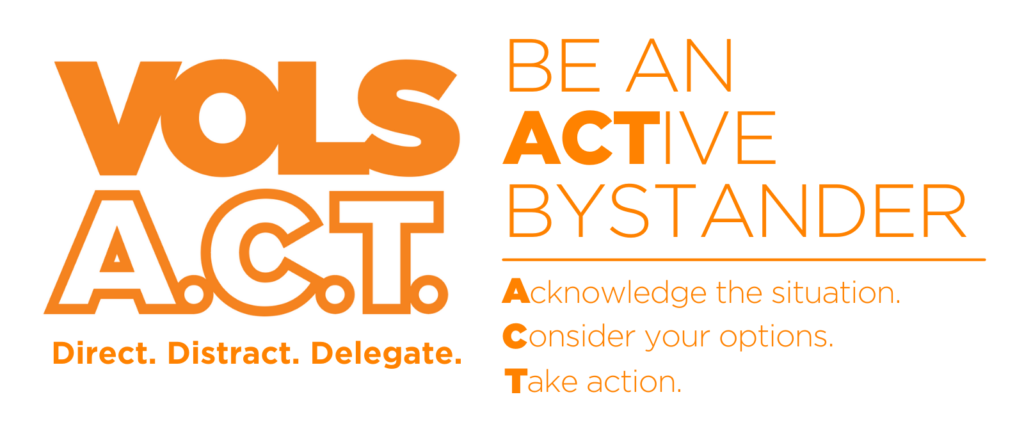Vols ACT empowers you to help keep UT’s campus safe for all Volunteers.
Every volunteer has a role to play in taking care of the UT community. Vols ACT trains UT students, faculty, and staff to recognize potentially harmful situations and safely intervene. Learn about the important role you can play as an active bystander to intervene in potentially harmful behaviors before they occur.
For Undergraduate Student Audiences: You can request a Vols ACT presentation for your undergraduate class, residence hall, student organization, or chapter.
For Graduate Student, Faculty, and Staff Audiences: For training for graduate students, faculty, and staff, you can register for Vols ACT. training through the Office of Title IX.
What is a bystander?
A bystander is a person who observes a behavior that is unacceptable and could be potentially harmful to another person’s health or well-being.
Examples include alcohol abuse, hazing, violence, sexual assault, relationship abuse, and discrimination.
As a bystander, we may:
- Think it is none of our business
- Hope that someone else will deal with it
- Miss an opportunity to change the community we live in for the better
What is an active bystander?
An active bystander is a person who takes the steps that can make a difference.
As an active bystander, we may:
- Positively impact the individuals we are concerned about
- Become a role model for others to have the confidence to speak up
- Create a community that values taking care of one another
How can I use Vols ACT to be an active bystander?
There are three key steps to being an active bystander.
- 1. Acknowledge the situation.
- Trust the voice within yourself that senses when something is wrong. Pay attention to your surroundings. If you feel like a situation you witness is off, wrong, or harmful, listen to that feeling.
- 2. Consider your options.
- Consider your options for intervening. Think about what you could do. What factors do you need to consider? Some include:
- Time of day
- Location
- Safety
- Situational power
- 3. Take action.
- After acknowledging that you should intervene and considering your options and safety concerns, it’s time to take action! You can act using the 3 D’s: Direct, Distract, Delegate.
What are the 3 D’s and and how can I use them?
The 3 D’s are strategies that you can use to intervene in a situation.
- Direct
- Step in and address the situation directly.
Example: “What you are doing is wrong.” “Hey, that’s not cool. You shouldn’t be doing that.” - Distract
- Provide a distraction that shifts the focus of the situation. This can include doing something to separate the victim from the situation or causing a physical distraction, like spilling a drink and asking for help cleaning it up.
Example: “Can you show me where the bathroom is?” - Delegate
- Find others who can help you to intervene in the situation. There is power in numbers. This can include asking a friend to intervene with you or getting help from security or staff.
Example: “Hey, I’m Smokey, will you help me?”
Your safety is important
When deciding how to act, it is important to keep yourself safe. It may not be safe to directly intervene sometimes, so distracting or delegating may be the better option. In other situations, you might decide to use all 3 D’s. To learn more about Vols ACT, the 3 D’s, and how to safely intervene, request one of our Vols ACT trainings!
